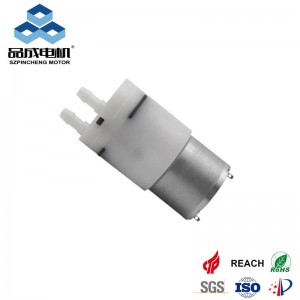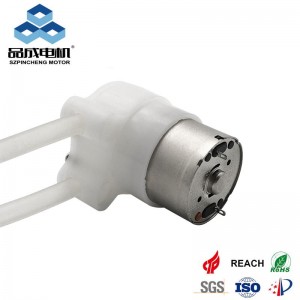Hey there! Looking to whip up some vacuum-sealed snacks, power a cool DIY science project, or build a nifty little suction tool? Mini vacuum pumps, like those palm-sized wonders from Pincheng Motor, are your ticket to getting it done. And guess what? You don't need an engineering degree to make them work! Let's break down how these bad boys operate, how you can build your own, and check out some ready-made options for a hassle-free experience.
Part 1: How Mini Vacuum Pumps Work – In a Flash!
Think of your mini pump as a pint-sized lung. Here's the deal:
Suck
A motor starts spinning a piston or diaphragm. This action pulls air out of a sealed chamber. It's like your lungs inhaling, but for air in a little box!
Seal
There's a one-way valve that traps the air that's been sucked in. It's like a little gate that only opens one way, so the air can't escape back into the chamber.
Exhale
The trapped air gets pushed out through an exhaust. It's the "exhale" part of the process, where the air that was inside the chamber is sent out.
Repeat
This cycle keeps going. And as it does, a vacuum starts to build up. The more the cycle repeats, the stronger the vacuum gets!
Key Specs Demystified
- Flow Rate: This is all about how much air the pump moves in a minute. For small pumps, you might see numbers like 1 - 5 LPM (liters per minute). It's like how fast your water faucet runs, but for air.
- Vacuum Depth: This tells you how strong the suction is. For example, if you see “−50kPa”, that means the pressure inside the pump is 50% less than the normal air pressure around us. It's a measure of how "empty" the pump can make the space.
Part 2: Build Your Own Mini Vacuum Pump – For Under $5!
Here's what you'll need:
- A 12V DC diaphragm pump (you can find one like this). It's the heart of your DIY pump.
- A 9V battery and some wires. These will power your pump.
- Plastic tubing with a 5mm diameter. This is how the air will move in and out.
- A jar with an airtight lid. This will be your "vacuum chamber."
- An on/off switch. So you can control when the pump starts and stops.
Steps to Build
- Drill two holes in the jar lid. One will be the inlet, and the other will be the outlet. It's like making two little doors for the air to go in and out.
- Connect the tubing:
- The inlet tube goes inside the jar. This is the one that sucks air from inside the jar.
- The outlet tube connects to the pump’s exhaust. It's where the air that's been sucked out of the jar gets dumped outside.
- Wire up the pump:Seal up the jar, turn on the pump, and watch as it sucks the air out of the jar! It's like magic, but with science.
- Connect the pump’s (+) wire to the switch, and then connect the switch to the battery (+).
- Connect the pump’s (−) wire directly to the battery (−).
- Seal up the jar, turn on the pump, and watch as it sucks the air out of the jar! It's like magic, but with science.
Safety First!
Never let the pump run dry for more than 2 minutes. If it does, it can overheat and might break. Think of it like running your car without oil – not a good idea!
Part 3: 3 Plug-and-Play Mini Pumps – No DIY Required!
| Pump Type | Best For | Example |
|---|---|---|
| USB-Powered | Crafts and small sealing jobs | Pincheng’s 5V pump (it's super quiet, only 45dB!) |
| 12V DC Diaphragm | DIY labs and food sealing | Pincheng’s PYP030-XZ (has a flow rate of 1.5 LPM) |
| Battery Handheld | Fixes on the go | Portable vacuum pen (for example, the 3.7V ones) |
Creative Ways to Use Mini Pumps
- Keep Food Fresh: Vacuum-seal your snacks in jars. Your chips will stay crispy for longer, and your cookies won't go stale!
- Science Fun: Use suction cups with the pump to lift objects. It's a great way to show how atmospheric pressure works. It's like a science experiment that's also super cool to watch.
- Electronics Repair: Get rid of dust from circuit boards. A little suction can clean up all that pesky dust that might be causing problems.
- Medical DIY: Create low-pressure environments, like for wound therapy prototypes. It's a way to test out ideas for helping people in a small, DIY way.
Mistakes to Avoid
- Leaky Seals: Make sure to use silicone tape on all your connections. Otherwise, air will leak out, and your vacuum won't work as well. It's like having a leaky balloon – not very good for holding air!
- Wrong Power: Always match the voltage. If you have a 12V pump, use a 12V battery. Using the wrong power can damage the pump. It's like putting the wrong size battery in your remote – it just won't work right.
- Overheating: Add a 5-minute auto-off timer. This will prevent the pump from overheating if you forget to turn it off. It's a handy little safety feature.
Pro Tip
If you're all about reliability, pre-made pumps like Pincheng’s PYP370-XZB are the way to go. They offer a crazy -70kPa vacuum depth, have a lifespan of 50,000 hours, and are as quiet as a mouse. Perfect for those daily projects where you need things to work right, every time.
Wrapping It Up
Whether you're into tinkering around or just want to upgrade your gadgets, mini vacuum pumps turn that "magical" suction power into real, hands - on science. And if you don't feel like getting your hands dirty with building, check out the ready-to-use kits from Pincheng Motor. They're plug-and-play, so you don't even need to know how to solder. Just pick one up, and start having fun with suction!
you like also all
Read More News
Post time: Aug-01-2025




